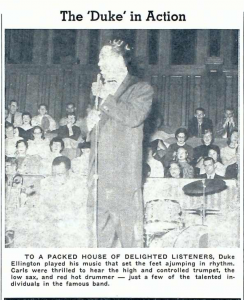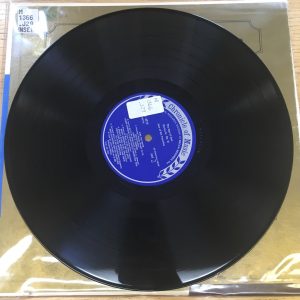Duke Ellington (born Edward Kennedy) became a prominent jazz musician throughout the mid 20th century. His name has become synonymous with jazz throughout households in the United States of America. As many jazz musicians, Duke Ellington toured across the United States with his orchestra playing the repertoire that would make the most money. In 1957, this orchestra and the esteemed composer himself made a visit to Carleton College on November 5th. And, in the tradition of great school newspapers, the Manitou Messenger advertised the concert. However, as intriguing as this article was, a little deeper digging revealed a more interesting resource: an article reviewing the concert from the Carletonian. To be fair, the Manitou Mess certainly wasn’t skimping on their coverage: the concert took place at Carleton, so it only makes sense for the more substantial review of the concert to appear in the Carletonian. The intriguing part of the article is the student’s opinion of the concert. The reviewer says that Ellington “proved once again, in Skinner memorial chapel, Tuesday night, that he is still one of the very best jazzmen around, with one of the very best bands.” The author goes on to praise Ellington’s jazz ability, but later in the article notes that despite Ellington’s status as a premier jazz musician, the concert was not “consistently good from a strictly musical standpoint”. The reviewer explains that the audiences more “sensitive ears” would have been repelled by the “exhibitionism” offered by some of the jazz soloists. Below is a recording of one of the pieces that were played at the concert:
As is often true of historical sources, this opinion on Ellington’s orchestra tells us more about the reviewer than the music itself. Duke Ellington’s career was on the decline by this point in the 1950s. He was focusing on writing sacred music and toured playing his most popular pieces. The author of the article points out that Ellington mainly played works that the audience knew and refers to Ellington as an “institution”. Even though the concert may not have been as musically perfect as the audience expected, they still knew that Ellington was an important part of history. Already, just a few decades into his career, Duke Ellington was a sacred relic.
This quick institutionalization of jazz figures is also reflected in the records of the time. While searching through the St. Olaf Halvorson Music Library for records of Ellington’s made around the late 1950s, I found it difficult to find a single record of Ellington’s music alone. The early solo record of his on file is from the 1970s. One record I did find from around the time was part of a Library of Congress series on Jazz music. Ellington appeared once on the record. It seems as if the effort to collect jazz and codify it as a genre began at the same time as the art form itself. This tradition of feeling a need to preserve and codify art forms like jazz was passed down from Blues collectors who also felt a need to define their genre. These two artifacts, in particular, illustrate the incredible spread and popularity of jazz throughout the country. However, they also represent the way white audiences controlled what music became popular and marketable, as well as the way jazz musicians’ careers depended on the benevolence of a fickle American public.
Mostly, however, I chose to write about this particular Manitou Messenger article because Duke Ellington came to Northfield, and Carleton didn’t like it. What a story.
and . “Ellington, Duke.” Grove Music Online. Oxford Music Online. Oxford University Press, accessed October 30, 2017, http://www.oxfordmusiconline.com/subscriber/article/grove/music/08731.
Manitou Messenger Archive
Carletonian Archive


